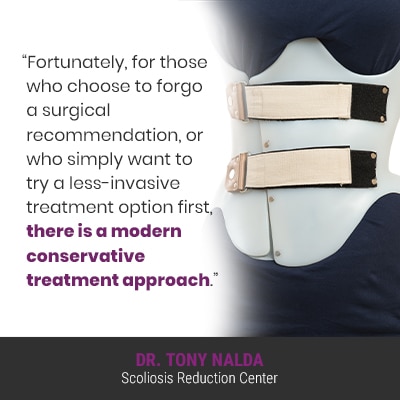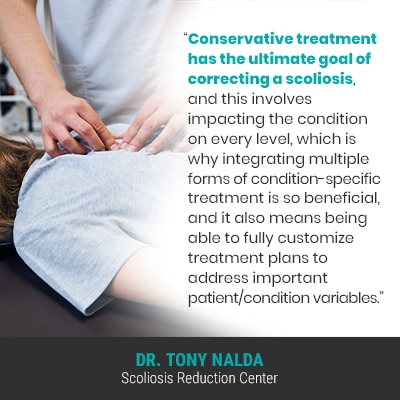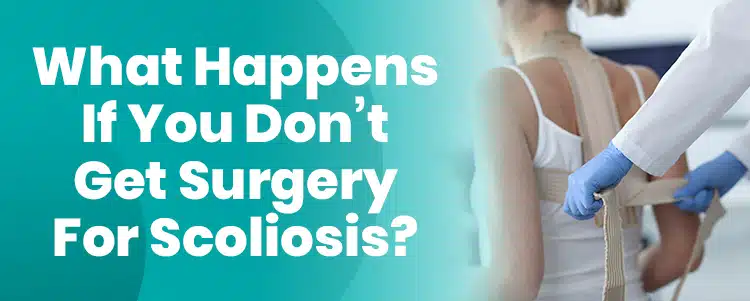There are two main scoliosis treatment approaches: one includes surgery and one provides a non-surgical treatment option. Surgical procedures always come with an element of risk, and spinal surgery is no exception. It’s important for patients to understand, however, that when detected early and treated proactively, there are fewer limits to what treatment can achieve, without facing the risks of surgery.
There is more than one treatment option for scoliosis: both surgical and non-surgical. The reality is that many cases of scoliosis don’t require surgery, especially those that are treated conservatively, but surgery can be presented to patients as the only, or best, treatment option available.
Before getting to the different treatment approaches, let’s first touch on some key condition characteristics.
Understanding Scoliosis
Scoliosis is a structural spinal condition that involves the development of an unnatural sideways spinal curve that also rotates, making scoliosis a complex 3-dimensional condition.
Scoliosis is also a progressive condition, meaning its nature is to get worse over time, and scoliosis ranges widely in severity from mild to moderate and severe to very severe.
So where a scoliosis is at the time of diagnosis is not indicative of where it will stay; only proactive treatment can work towards counteracting the condition’s progressive nature.
The spine’s natural and healthy curves make it stronger, more flexible, and better able to absorb/distribute mechanical stress incurred during activity, so when the spine develops an unnatural curve, the biomechanics of the entire spine are disrupted.
A spine with an unnatural curve means its vertebrae aren’t aligned as they should be, and a misaligned spine introduces a lot of uneven forces to the spine, its surrounding nerve and muscles, and the body in general.
An important distinction to understand is that traditional treatment is more reactive, while conservative treatment is proactive.
Now, when a person is diagnosed with scoliosis, the most important decision to be made is how to treat the condition moving forward, and this will involve committing to one of the two main scoliosis treatment approaches: traditional vs conservative.
Traditional Scoliosis Treatment and Surgery
Traditional scoliosis treatment involves a lot of watching and waiting, quite simply, because it doesn’t have a strategy for treating scoliosis while mild.
Traditional treatment recommends observing patients with mild scoliosis for signs of progression, but as a progressive condition, it’s virtually guaranteed to get worse at some point, so waiting for it to do so, to me, is wasting valuable treatment time.
The only form of treatment used, prior to a surgical recommendation, is traditional bracing, which is associated with a number of shortcomings, mainly related to its refusal to address the condition’s 3-dimensional nature: ignoring its rotational component.
If bracing is unsuccessful and a patient progresses into the severe classification, with a Cobb angle measurement of 40+ degrees, they are presented with spinal fusion as the best remaining treatment option.
Spinal Fusion
Spinal fusion is a costly, invasive, and risky procedure that comes with some serious potential risks, side effects, and complications.
Spinal fusion involves fusing the curve’s most-tilted vertebrae, at its apex, into one solid bone, and this is done to eliminate movement (progression) in the area; the bones can’t become more tilted.
Rods are commonly attached to the spine with pedicle screws to hold it in place, and these rods are permanently attached to the spine.
A fused spine is fused for life, and if surgery is unsuccessful, or complications such as a hardware malfunction, or an adverse reaction to hardware used, develops, the only recourse is more surgery.
A fused spine is contrary to the spine’s natural movement-based design and makes it more vulnerable to injury, and one of the main complaints patients have post-surgery is a loss in spinal flexibility and range of motion.
While some patients maintain enough spinal flexibility above and below the spine’s fused section, many experience enough of a loss to affect overall quality of life.

Fortunately, for those who choose to forgo a surgical recommendation, or who simply want to try a less-invasive treatment option first, there is a modern conservative treatment approach.
Conservative Scoliosis Treatment without Surgery
Here at the Scoliosis Reduction Center®, I treat patients with a modern conservative non-surgical treatment approach as this is in line with the spine’s natural movement-based design.
While traditional scoliosis treatment has the goal of stopping progression, although that is also a goal of conservative treatment, it’s approached differently; conservative treatment has the main goal of correcting a scoliosis on a structural level, which also impacts progression by addressing the condition’s underlying structural nature.
The treatment center’s success proves that many cases of scoliosis don’t require surgery.

Conservative treatment has the ultimate goal of correcting a scoliosis, and this involves impacting the condition on every level, which is why integrating multiple forms of condition-specific treatment is so beneficial, and it also means being able to fully customize treatment plans to address important patient/condition variables.
Conservative treatment responds proactively to a scoliosis diagnosis by starting treatment immediately; this is important because scoliosis is simpler to treat while mild, before progression has occurred, making the spine more rigid and less responsive to treatment.
Waiting to start treatment can mean allowing a condition to progress unimpeded, and this is a risk I don’t take, especially with my young patients who are at risk for rapid-phase progression; growth and development triggers the condition to progress.
Chiropractic Care
To impact the condition on a structural level, chiropractic care uses a series of techniques and manual adjustments to work towards repositioning the curve’s most-tilted vertebrae back into alignment with the rest of the spine.
A spine that’s aligned is one that has its natural curves in place, and an aligned spine is one that’s not exposing its surrounding muscles and nerves to uneven pressure.
Physical Therapy
As it’s not just the spine that’s in charge of maintaining its natural curves and alignment, but also its surrounding muscles, physical therapy that increases core strength can help by making sure the spine’s surrounding muscles are strong enough to optimally support it.
Physical therapy can also help with improving posture, activating certain areas of the brain for improved brain-body communication, achieving a more natural body positioning, and addressing any related muscle imbalance.
When the spine has a scoliotic curve, it can cause related muscle imbalances as it pulls the spine’s surrounding muscles in different directions; this can cause the muscles on one side to become stretched and loose from overuse, and the muscles on the opposite side to become weak from underuse.
Corrective Bracing
Modern corrective bracing represents the culmination of what we’ve learned about scoliosis bracing, and treatment efficacy, over the years.
Corrective bracing addresses the shortcomings associated with traditional bracing by treating scoliosis as a 3-dimensional condition, pushing the spine into a corrective position, rather than squeezing it unnaturally, and ensuring that each brace is bespoke to its wearer through a series of comprehensive measurements and state-of-the-art scanning technology.
The ScoliBrace can be particularly effective on growing spines so is a common facet of treatment for the condition’s most-prevalent form: adolescent idiopathic scoliosis.
Rehabilitation
As scoliosis is a progressive incurable condition, work has to continue to maintain treatment results, and this can involve continued chiropractic care, and a series of custom-prescribed home exercises to help patients establish a home-rehabilitation program to further stabilize and heal the spine.
Conclusion
So what happens if you don’t get surgery for scoliosis? For those on the path of conservative scoliosis treatment, treatment success means achieving corrective results that include preserving as much of the spine’s natural strength and function as possible.
For those patients on the traditional path of scoliosis treatment, risks associated with spinal fusion can include excessive blood loss, nerve damage, infection, pain at the fusion site, and a reduced range of spinal flexibility and range of motion that can affect overall quality of life.
While a fused spine can hold a straight position, it does so through artificial means that are contrary to its movement-based design, so a fused spine is not going to be as strong, or function as well, as a scoliotic spine that’s been corrected on a structural level.
Here at the Center, I integrate multiple treatment modalities into a treatment plan so a curvature reduction is worked towards, core strength is increased, corrective bracing helps by pushing the spine into a corrective position, and rehabilitation facilitates long-term sustainable treatment results.
So if you, or someone you care about, has been diagnosed with scoliosis, don’t hesitate to reach out for guidance and support to ensure you are on the right path for effective treatment.




